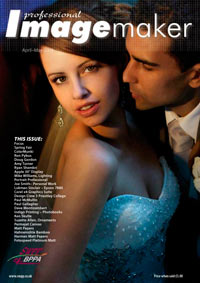articles/Review/moodindigo-page2
Mood Indigo - part 2 of 1 2 3 4
by Mike McNamee Published 01/04/2008
Indigo printing is different to other ink-on-paper systems. Developed originally as the E-1000 in 1993, the system still relies on the use of ink suspended in an Imaging Oil and the particles are pushed or pulled into the right place with electrostatic attraction generated by lasers. This gives the versatility of the photocopier, with the speed of offset litho, the main difference being the complete absence of plates.
The plate is replaced by the Photo Imaging Cylinder which is wiped clean every revolution of the system. The new Indigo 5500 is offered with four, five, six or seven inking stations. Adding inks beyond the standard cmyk set increases the gamut and/or the smoothness of tone. Light magenta and light cyan have been added as the preferred options for portrait and wedding album work. The Indigo 5500 recently won the DIMA Digital Printer Shootout in the digital press category.
While the early Indigo systems struggled to match photographic output for quality, this is no longer true and prestigious companies such as Graphistudios mix silverphotographic and Indigo output in their lists, at exactly the same price. Talking to long-term users of Indigo-printed album products, confirms that it is only photographers who notice the tell-tale rosettes of the dot structure, the punters do not care a jot!
The technology also offers the possibility of each page being unique, the so called 'variable data printing' (VDP) which perhaps addresses the individual recipient by name. Yophoto quoted the example to us of industrial clients who call off staff-handbooks, one at a time, for new company-starters, which are personalised, but also flexible should legislation, department names, etc change between two output runs.
Indigo printing and its rival short-run technologies offer many options for self-publishing. The boundaries are those set by the photographer's imagination and by the current cost. For example, a photographer might create a book of images that were shot as progress records for an architect. The sums involved and the prestige of completing a large project are such that the architectural practice might welcome a large-format glossy book for their reception area, with smaller books handed out as thank-you gifts to collaborating sub-contractors. Yophoto will create you a traditionally hand-stitched photobook in A4 size of 40 pages with a linen hardback for £40.
They can also provide premium, leather-bound versions for the board of directors! While other vendors are competitive in price, there is generally a page limit of 40 pages which rules them out as a means of creating a technical, instructional book, but they are well-placed to provide portfolios. The background to Yophoto's parent company is business printing and so they have a more sophisticated workflow, with many options for binding and page count. They can, for example, RIP pdf files containing mixed text and graphics (such as we create for Professional Imagemaker) - some of the more consumeroriented vendors cannot provide this service, limited only to JPEG file-input.
Please Note:
There is more than one page for this Article.
You are currently on page 2 Contact Mike McNamee
1st Published 01/04/2008
last update 09/12/2022 14:56:50
More Review Articles
There are 0 days to get ready for The Society of Photographers Convention and Trade Show at The Novotel London West, Hammersmith ...
which starts on Wednesday 15th January 2025





